
|

|
Forum Index : Solar : Deciding if I should build this solar heater
| Author | Message | ||||
| rogerdw Guru Joined: 22/10/2019 Location: AustraliaPosts: 852 |
Haha ... sounds great. I'm looking forward to that, especially on these cold mornings.  And will be better on the roof too because when it first fires up (8:17 today) ... the tubes are still one third in the shade of the fence. Cheers, Roger |
||||
| Warpspeed Guru Joined: 09/08/2007 Location: AustraliaPosts: 4406 |
Think of this as not heating the house, but keeping the tubes cool. More tubes + more heat requires a larger airflow to remove that heat from the tubes. Edited 2021-07-29 10:37 by Warpspeed Cheers, Tony. |
||||
| rogerdw Guru Joined: 22/10/2019 Location: AustraliaPosts: 852 |
Ok, interesting way to look at it. I now have two sensors inside the tubes ... the original one that has been there a couple months and that shows in all my charts ... ... and the new one that is connected to the differential controller. Both have the sensor about half way down the glass tube, between the aluminium tube and the glass. And 1st one is in the third tube in from lhs ... and 2nd one in the first tube on the left. What I find interesting is that often they are within a degree of each other ... and sometimes as much as 10 degrees apart. It may be that I just happened to look at a time when there had been a fairly quick temp change and the data logger sensor was not keeping up ... remember, they are the type that I have found a bit slow ... and why I've ordered the new tiny thermistors to take their place. The other thing that comes to mind is the concept of keeping the air inside the tubes longer to transfer more heat. Marcel, the guy on youtube who also played with this concept, used a spiral copper 'winding' around his metal tube to make the air spiral around the tube on its way back up ... to slow it down and to pick up more heat. I couldn't think of any easy way to replicate what he had done ... other than to perhaps, wind some springy curtain hanging wire around just one or two turns from bottom to top ... to do something similar. Of course I'd need to use some without plastic if it is available ... because in summer the stuff is going to overheat badly and probably go all brittle and flake off and block up the works. Otherwise again, maybe I need to try Dave's idea of drilling a few holes in the sides of the tube and partly restricting the bottom exit ... to stir the air up a bit more and create some turbulance. Maybe those holes should be mostly on the top of the tube because that is way hotter than the bottom of the tube, because of the direction of the sun. Anyway, just tossing ideas around. Needs more experimentation. Cheers, Roger |
||||
| Warpspeed Guru Joined: 09/08/2007 Location: AustraliaPosts: 4406 |
There will always be a balance of heat flow, the tube temperature will rise in the tubes until there is enough difference between the tube temperature and the air temperature. We are definitely not trying to achieve high temperatures, but highest possible heat flow. Thinking of all this in terms of maximum cooling effect of the tubes might help to visualise what we are trying to do in a slightly more helpful way. The system you have now might benefit slightly from fitting a second blower in series, perhaps one of those Bunnings extractor fans with the motor reversed might be enough? Only some testing and experimentation will suggest the best way of increasing the airflow, although the system you have now is working pretty well. I suspect the much larger system will definitely benefit from having possibly about four times the volume of airflow to what you now have. That might end up being too noisy and impractical, but it will definitely work better with more airflow if you can find a way of doing it. Cheers, Tony. |
||||
| Davo99 Guru Joined: 03/06/2019 Location: AustraliaPosts: 1578 |
Exactly what I have found and my new law of heat soaking/ Maintaining temperature. Mrs is home this week and interfering with my domestic Thermal Management. I have been putting on a heater, the diesel or fan, between 4-5 Pm depending on weather. Yesterday was nice and warm here, initially at least, so much so my 2 beloved dragons ( Blue tongues ) came out of hibernation. Bit early I thought but who am I to tell them? Fired the heater at a bit after 5 even though it did not feel needed and in fact the heat gun aimed at it's regular spot said it was 20 in there. Someone interfered and turned off said heater. By 7Pm they were complaining it felt chilly. Down to 18 and falling. Had the Diesel and the electric going pretty hard till about 10 Pm to get it back to 19. Had the fan heater been left the hell alone It would have maintained temp all on it's own, possibly on the lower setting and Not needed to be cranked WITH the diesel going as well. Even if the temp is ok, I have been putting the heaters on so there is no fall off rather than trying to bring the temps back up and have the cold working against us. Even if the temp Initially pushes a bit higher, it's a short lived reserve for the rest of the night and it's certainly never got too hot later on. Same with the AC. Been giving that a run about 4 PM to equalise the temps a bit. Only runs for 5-10 Min then cuts out. Was kicking in now and then when it was 5 o or less but above that the other heating is adequate. Also better to give that a run when there is some heat outside for it to work with rather than trying to pull something out of 3 o air. I have been relying on the thermo because my/ our sense of temperature can be very accurate but also very poor. Sometimes feels Chilly when the temp is normal or even a degree up. Other times especially if one has been out, it feels really warm, at least for a while, when it could be fractionally cooler. One thing I have noticed this year is the women aren't constantly trying to crank the AC to 30 and still bitching about the cold. Daughter turns her room into a sauna on occasion but better than the whole house. I maintain in this case, slowing the air is not the solution. Slow air won't change the effect of the boundary layer gasses that will make the air Column hot on the outside and then failing to pick up heat while still being cool on the inside. Those long, smooth tubes are going to be perfect for creating boundry layer / stratified gas columns within the tube. What is needed is turbulence to break up those boundary layer gasses and get as much of the gas as possible in contact with the inner ( smooth) tube surface to allow for greatest temperature differential and heat transfer. I noted he also remarked about not causing extra resistance which is important. That is where I think the Holes in the inlet tube would be effective. It may be that you would want to drill one every so far down the tube and have them pointing up where the majority of the heat will come from. I envisage the percentage of looses being smaller on the large system so 3 Times larger may mean 4x more heat potentially. As far as Blowers go, My favourites are the Jumping castle Blowers. I thought these might be over kill going on what you are presently using but as Tony points out, not really keeping up now and you are going to be putting in a system 3x bigger. That will also have more air resistance so a Proper high speed blower might be what is needed so there is adequate air PRESSURE as well as Volume. You can always turn a Blower down with a PWM controller like I do for the burners. Wouldn't be hard to stage one with a Couple of PWM's and a DPDT relay. The other possible solution seeing you have a couple of fans is to do one pushing and one pulling or, Y them together on the inlet. I think that would be inferior to the push pull because you are going to be increasing resistance on the front side instead of lowering it on the back. There will be more warm, expanded air coming out than cool air going in. For that reason it may be wise to increase your ducting size on the back end or double it to allow for the greater gas volume and lower resistance on the cold side. This is something I found with Burners. Obviously the expansion I see is a lot greater but I design everything with larger outlets than inlets now. I opened the outlet of a couple of them up and the difference was huge in performance and also how much I could slow the fan to get the same output. I'm also pushing the air with a lot more force but over a much smaller area and with far less restrictions so I think keeping the resistance and air expansion in mind would be wise especially if you don't want the temps going too high. I forget the temp but from memory, the greatest percentage of expansion is at pretty low temps probably where you will be especially with the cold and possibly humid air intake temps you will be working with. Air has mass and ducting causes friction and there are formulas to show how much that increases with every foot of ducting or every bend you make the gas flow take. Exactly the same for water. Longer the run, more bends you make it travel, the harder it is to push. Bit like power as well. |
||||
| Warpspeed Guru Joined: 09/08/2007 Location: AustraliaPosts: 4406 |
Dave is quite right about ducting creating significant back pressure. High speed axial fans can move a lot of air, but they definitely do not like back pressure. Axial fans in series makes more sense where a lot of ducting is involved. Centrifugal blowers are much better where there are higher pressure ratios. A larger diameter centrifugal run at low rpm can produce very little noise, while moving a lot of air against some back pressure. Once the air goes down your aluminium tube, and does a 180 at the bottom, its going to be pretty turbulent, and stay turbulent back up the outer tube. Greater airflow should fix all those kinds of problems without doing anything else. Cheers, Tony. |
||||
| rogerdw Guru Joined: 22/10/2019 Location: AustraliaPosts: 852 |
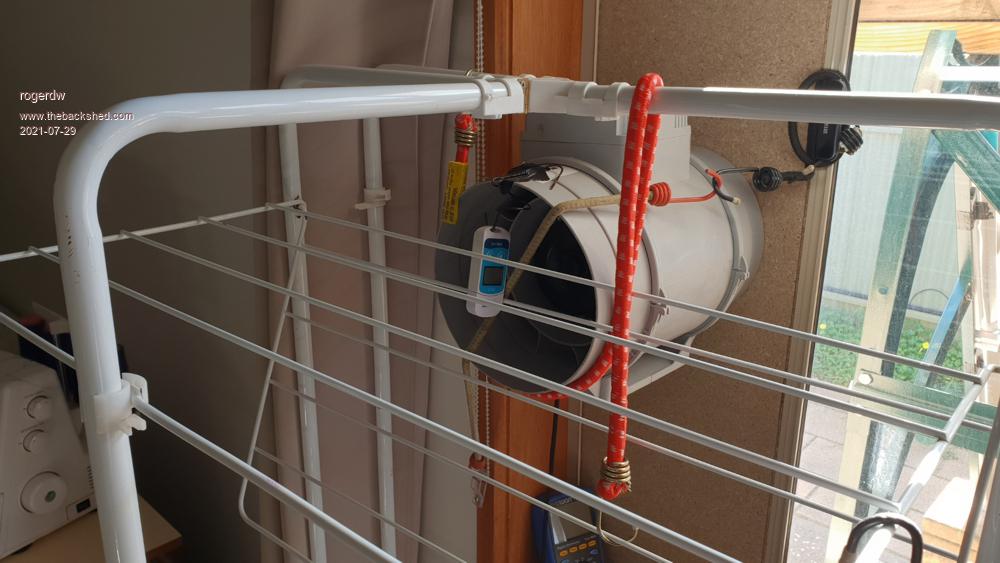 What's wrong with that?!! Just don't show Dave.  Well the air velocity is up to 6.3 m/sec from just over 4 ... and the tube temperature is not dropping by much yet. I'm a bit afraid my data logger battery is dying ... display is not staying on for long ... may be the reason for the glitches the last couple days ... yet it measured ok several days ago when I altered the thermistor position. Cheers, Roger |
||||
| Warpspeed Guru Joined: 09/08/2007 Location: AustraliaPosts: 4406 |
Ah, fifty percent more air at the same temperature, you know what that means... Cheers, Tony. |
||||
| Davo99 Guru Joined: 03/06/2019 Location: AustraliaPosts: 1578 |
The washing sitting in front of the fan on that clothes airer is going to dry Quicker? |
||||
| Warpspeed Guru Joined: 09/08/2007 Location: AustraliaPosts: 4406 |
At 6.3 m/sec I think the washing will be swirling around the room. Enter with extreme caution, and hang onto your hat. Cheers, Tony. |
||||
| rogerdw Guru Joined: 22/10/2019 Location: AustraliaPosts: 852 |
29/07/21 Thursday ... forecast was for 18 degrees and mostly clear. Even though I had checked the battery voltage a few days ago ... I finally woke up to the fact that the battery was probably going flat in the outlet logger because the display started to look pretty faded when I pressed the button to show the display. Under a 3mA load they all dropped to about 2.8v ... so tonight I replaced them all. The day started with the first fan run about 8:17 ... same time as last few days. The fence shades the bottom third of the array at that time ... so on the roof should start earlier if good sun. It's unfortunate that the output logger's data was corrupted as there was some useful info that was missed. I've placed that chart below but even though it ran for the same length of time as the others ... its final data point was at 14:01 ... while for the others it was at 16:33 After the discussion this morning I decided to fit the 8 inch inline fan on the outlet to help suck the air out of the tubes ... while still keeping the original fan blowing air through. You can clearly see the point that I turned it on at 12:22 because the temperature in the tubes nose dived as more heat was being sucked out. There wasn't a corresponding drop in sun temperature ... so can't blame that. The only issue is that at 13:22 I switched the fan to high speed ... and you cant really see any major effect. It does seem that the inside temperature took a leap forward at that point ... though I do wonder if it was because I was mucking about fitting the fan and held it all back for a while ... and then once it was free to run ... it caught up quickly. Not sure. The inside temp went from a low of 14.8 up to 20.9 degrees ... that's a 6.1 lift. There was no cycling at the end of the day because the big fan was not connected to the differential controller ... and when I saw the output was down to 25, I turned it off manually. 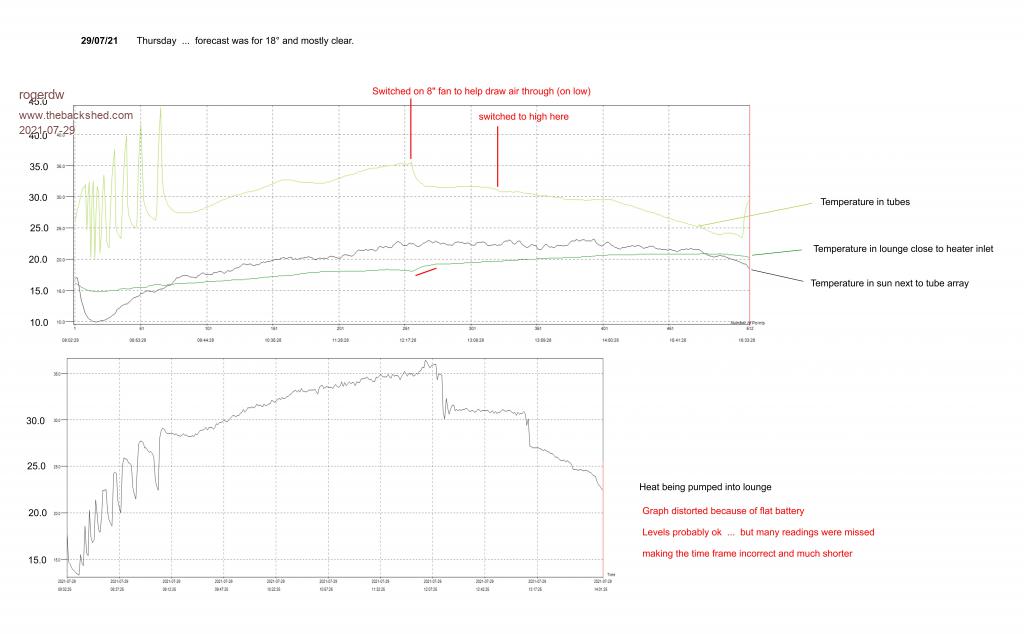 Cheers, Roger |
||||
| Warpspeed Guru Joined: 09/08/2007 Location: AustraliaPosts: 4406 |
It seems more air is noticeably better. It should make an even bigger difference with the larger system. Cheers, Tony. |
||||
| rogerdw Guru Joined: 22/10/2019 Location: AustraliaPosts: 852 |
It's a real pity I wrecked that other 6" fan ... it would be just right to assist the other one. Yeah, well this one is definitely noisy ... especially on high speed ... and impractical too ... but it's helping with our understanding of how the heater works. With this existing unit, the 6 inch duct is more cross sectional area than the total of the tubes ... so it is the csa of the tubes that is the limiting factor. It will be the same with the new one in that everything revolves around the size of the aluminium tubes and the return airflow path between the ally tubes and the glass back into the main plenum. A nine inch duct will be too small and a 10 inch, over size ... so will need to be a 10 inch duct in and out. So my 6" and 8" inline fans are not going to be a good fit ... and I will have to find something more substantial. I have done a lot of reading over the last few weeks and was starting to lean towards a decent sized centrifugal fan to push a decent gale through the heater ... and then channel it to the different rooms at the other end. Those ducts can be smaller of course ... probably 8 inch ducts. I've mentioned my scrappee mate who wrecks lots of airconditioners ... well when I visited him last I spotted this really clean and nice looking dual fan assy ... and once I'd drooled over it, he said to take it home. I can't see this one being a fit in my new system ... but I'll bet he has something a lot closer in his megapile of dead aircons. Of course, there's no point going through all his stuff until I have it clear in my mind, just what I'm looking for. 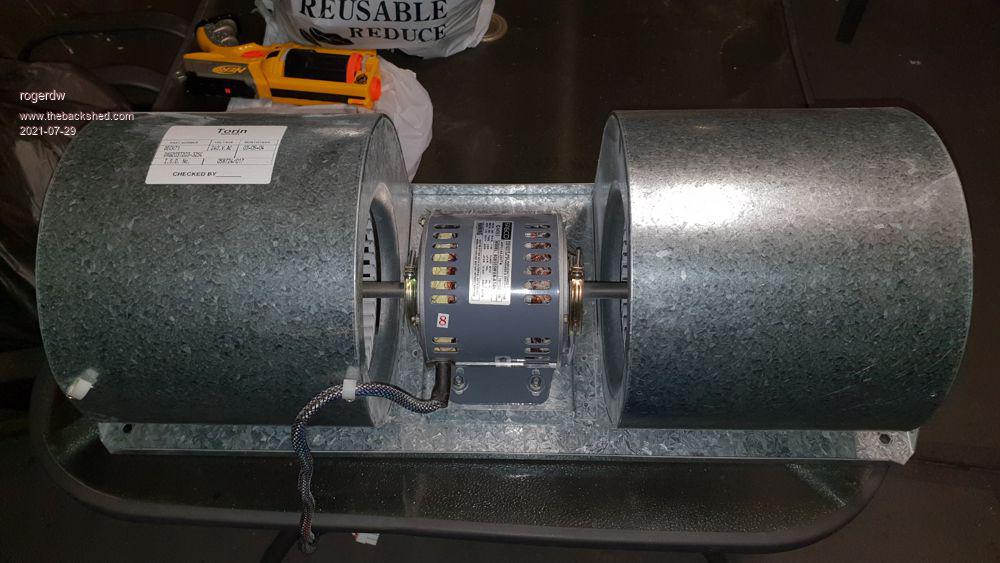 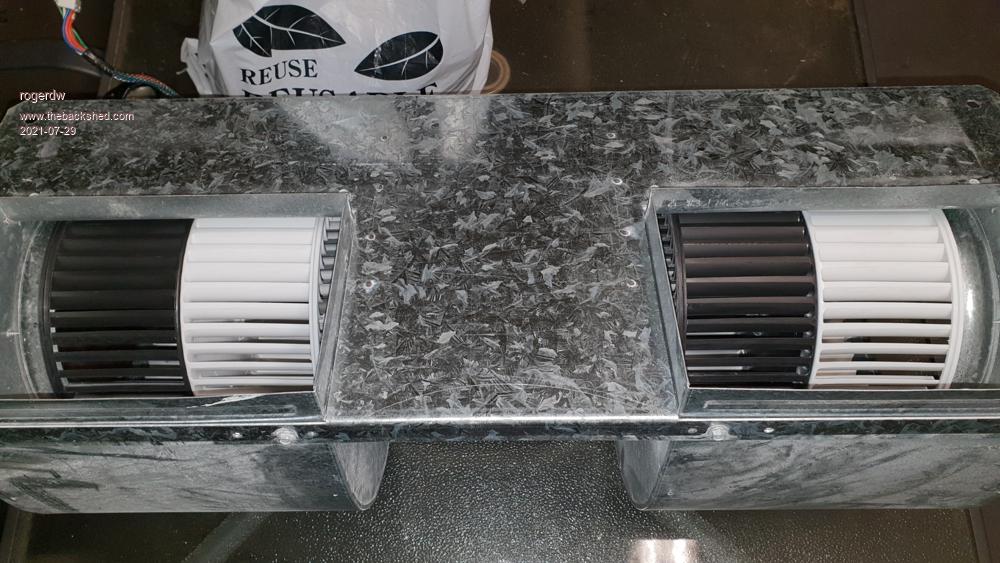 Cheers, Roger |
||||
| rogerdw Guru Joined: 22/10/2019 Location: AustraliaPosts: 852 |
I came in tonight at 6 and relit the fire. It's vastly better than last night, so just needed more heat and from earlier on. Haha, they can do that sometimes ... the best laid plans of men and mice ... Agreed, seems I've just learned that too. I think I got caught out last night because I came in from helping my mate in the glasshouses ... and it was so much warmer inside than out there, that I thought it was ok. Between you and Tony, you've given me a new idea how to fairly simply create a bit of extra turbulance. What I might try is to make a heap of 10mm cuts into the bottom of each tube, 10mm apart ... then use a pair of pliers to give each tab a bit of a twist ... so that the air gets a bit of a deflection to maybe help it spiral back up the tube creating some decent turbulance. Yeah, I noticed early on that with a tube in the sun ... the inner top was always much hotter than the inner bottom ... which makes sense because the sun is hitting the outside of the top ... so having some holes through to there was the aim ... but I'm not sure I'll even bother with that. That would be nice ... and there's definitely areas that I aim to improve. Just having an insulated hot air duct outside has to make a huge difference. There's no question they can push some air ... but the one I have I reckon was around 450 watts to run ... while my inline fans were around 45-50 ... though this latest 8" one is ~100 watts on high. Especially if I use DC from pv. That was my initial thoughts ... but with the size I need, I'll need to spend a lot to get something suitable. I'm definitely out of my depth ... that's why I really need to talk to an aircon ducting person to make sure I'm heading the right way. Yes, I was starting to lean towards a centrifugal fan anyway ... and it could also solve one of my other problems ... ... until recently I was expecting to have 90 degree elbows at each end of the main ducting, down through the tiles ... and then carry on in normal flexible duct. If I were to fit a centrifugal fan at the inlet of the cold duct up on the roof ... the inlet to that fan can be at 90 degrees to the duct ... which means I wont need an elbow ... the fan will redirect the air at 90 degrees. And that will also keep the noise further away as well ... though of course then I have to make sure it is all weatherproof. When I switched it to high ... it was 7.1 m/s ... plus started to sound like it was going to take off.  Cheers, Roger |
||||
| Warpspeed Guru Joined: 09/08/2007 Location: AustraliaPosts: 4406 |
Something like this single entry blower might have roughly about the right proportions and should develop a usefully high pressure at not too high rotor tip speed to become really noisy. Just as Dave suggests, the classic "jumping castle" style of blower might make an excellent starting point. 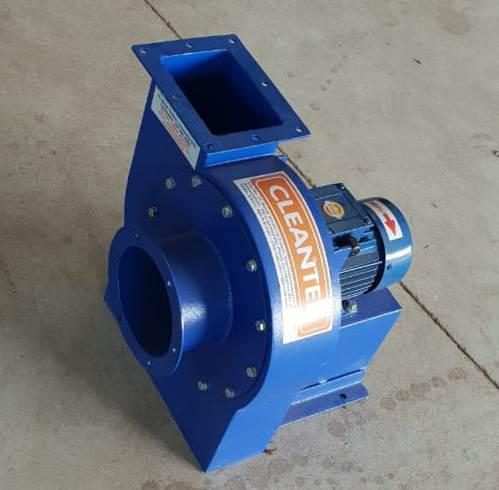 A big fat double entry blower like this one, can shift a lot of air, but will be very lacking in pressure. Attempting to drive it faster to gain pressure will suck up a lot of Hp. 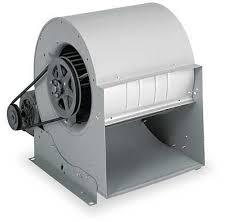 Going to the other extreme, this really skinny blower could develop phenomenal pressure at a very high (and noisy) tip speed, but would be seriously lacking in flow. 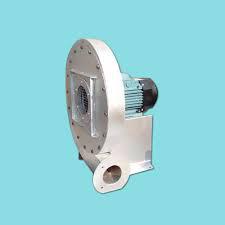 With a practiced eye, and a few figures its possible to tell just by looking the probable flow and pressure capability, along with the rating plate on the motor. Edited 2021-07-30 01:45 by Warpspeed Cheers, Tony. |
||||
| Davo99 Guru Joined: 03/06/2019 Location: AustraliaPosts: 1578 |
I would technically Nit pick and say you needed to offset the thermal losses escaping from your home before the internal temp nose Dived. :0) I did too last night, -2 here again. I can still see the Birdbath outside the office window is frozen solid. And more thermal management interference. Got up during the night, 6 Times, it was a rough one, and found the fan heater switched off. Put it on again and when I got up this morning it was off again and the room was Barely 17. I don't get it. The women are walking round like they are Eskimos in this silly looking "oodie" thing complaining of the cold after they have turned heaters off. Last year they would have had the AC at 30 and running round in a T shirt and shorts complaining they are cold. No happy medium!! The exact trap I was falling into. Thats why I check with the thermo. Unless it's 25 Or something inside, which it never has been so far, I put them on. Usually although I -think- it's warm, it's usually a degree or 2 below in fact so on they go. On this my ideas differ a bit to Tonys. I agree that the air will be very turbulent once it comes out the inner tube at the bottom but I think it will soon straighten out. It will be going up a narrow ,smooth passage between the Vac Tube and the air Inlet tube. Both smooth surfaces that if anything, will work against Turbulence. I am of the opinion that some stirring will be beneficial. Doing tabs may or may not be OK and I think that's going to get into a very unknown area real fast. They will HAVE to create a resistance or they won't work. Depending on the gas flow, some resistance won't matter as the flow will still be under the capacity of the tube to handle it at the given air pressure. Where you cross that point however will be all but impossible to define however and if you go too far potentially you will loose heat. If you had a mag meter you could probably test it on a single tube and see the difference in heat output as well. I don't think you could put too many holes as they are all a way to lower the distance travelled therefore offset any resistance they do cause substantially if not completely. The Tabs will definitely work but I think like holes you need them every so far to stop the air smoothing out between the glass tube and the inner tube. Air does like to hug and follow surfaces, Boundary layers are a basic concept in avionics and jet engine design. Also why it's harder to make efficient model Jet engines than full size ones, because the boundary layer of gas that sticks to the compressor blades is the same as on a full size engine but obviously a much higher inefficiency in a 70mm compressor wheel that a 3 meter one. I do think the hole in the air tube idea is better because the resistance will be minimal and the disturbance can in fact be aimed to the hottest region of the tube, the upper surface. It would also seem easier and faster to me to drill holes than make the Tabs. Perhaps you could set up a couple of tubes and do one each way and see if you can discern a difference in air and heat flow? Thing is, air has mass. You are not going to move the same MASS of air which is the combination of volume and density, with 100W as you are going to with 400W. Right now, you already need to move more air so need to put more power into it. You can use your 100W to move MORE air, you can use it to move air at Higher pressure but given the same relative efficiency, You aren't going to move more air at higher pressure without imparting more energy to the process. A reason I suggested the castle blower with the PWM was because It would probably have sufficient flow and more than enough pressure and you could then tune it to what you needed. I look at it this way, even if you run the thing flat out at 400W, you are getting 4KW, 10 times the energy invested as heating output. How much more efficiency do you want mate?? :0) That's beyond cutting edge for any Commercial process I know of! What is AC EER? 4-5X? Now I'm a tight arse but geez, got to be happy with that! And look at the back end, you are going to put up panels and have a warpinverter powering things as well so why worry? Kw of panels will have the fan consumption covered probably 100% of the time given when there would be excess you could be diverting making up for when they weren't covering that much.... Which they may anyway because at that point the blower may be cycling rather than running constantly... unless it is set up at variable speed at which point it probably would be covered! I sure would be happy to pump 400W of electrical power into something and get 4 Kw of heat out but I guess some people are just kind of fussy like that and hard to please! :0) Much as I like the Direct PV idea, I think you would be chasing your tail and wasting your money trying to get a powerful enough DC fan or fanS for this project. Maybe you could do a treadmill motor on a Castle Blower but is it really worth the arsing around? What you and Tony might be able to work out is an inverter that has no low voltage cut out... if that is workable. Lower input, lower output. As long as you don't use a motor with a start winding that would fry if you ran it before the run winding kicked in, and the plastic blowers I have seem to use universal motors that don't have that, then You should be fine that side. He might have a Mag meter and can do the flow if he does Commercial/ Industrial Setups. I know my Mate in AC has because he does a lot of hospitals and things and there are always specified room Turn over and flow rates and he has to calculate pressure Drop so he knows the size air handlers he needs to put in. I know he does much like I suggested with the PWM. Oversize fans running on VFD's so they can be under driven for Longevity and Noise. Same as Chiller pumps. Over sized, under driven. A reason I put the Diesel heater outside blowing in instead of the other way around.... And if the thing burst into flames better out than in as well. :0) My bathroom exhaust fans are set up the same way. The motor is not on the ceiling, it's half way along the duct High up in the roof suspended on rubber Straps. Have to listen to the thing to hear if it's on rather than others that sound like a Blender in the room. I would also suggest that your resistance is not going to be much on the open ducting but blowing air down and back up those tubes and along the manifold is what you are going to have to worry about. That made me laugh! Turn the whole room into a Clothes Drier and wouldn't they come out soft and Fluffy! Hope the cat don't walk in there! Yeah, I bought a real good Industrial inline like your 20 Years ago For blowing models hair around to give them that Big hair look. Thing Cost a bomb but Of course the ones sold for the Job which were the same but painted black, like everything has to be in my game, were twice the rip off. It fairly howls as well when Cranked up and will blow their hair extensions and fake Eyelashes off if they aren't put on right. At lower speeds it's pretty quiet. I think a Centrifugal blower either in the ceiling or outside would be the way to go. I would also suggest talking to your AC mate about some Filters. I would be putting one on the Inlet to keep the system free from of dust build up and inhaling errant escaped Budgerigars etc as well as not pumping the house full of dust. I want to do that here. Put in a fan pulling through a filter to pressurise the place a bit when the ambient air is warm ( or cool enough) and keep the dust outside. I was going to put a filter on the Diesel inlet but it's been pretty damp all winter so the dust has been low thankfully. For the air flow you will be doing, I think it would be worth while. You can buy pre made housings that take the paper cartridge Filters that are cheap. Helped my mate change them out in buildings several times and you just slide the old Crud encased full of Yecch one out, give the housing a wipe off and put the new one in. Wouldn't be hard to put a flange over the blower inlet and connect the filter housing with a short length of Duct. I'd be surprised if a filter didn't last several years given what I have seen changing Commercial ones that run 12 Hours a day 5 days a week at least that are swapped annually. |
||||
| Warpspeed Guru Joined: 09/08/2007 Location: AustraliaPosts: 4406 |
I have been looking at some of the specifications of those jumping castle type blowers, two things stand out, the developed pressure is not all that high, typically 1,000 pascals, about 0.145 PSi or four inches of water rise, and they are rather noisy 70db to 90db. The airflow is quite high though. I think the next step would be to first make some measurements on your small system on a nice sunny day. We need to know the temperature rise, the air flow, and the pressure drop across the sixteen tubes, preferably using a simple water manometer. From that we can estimate the required airflow and pressure drop for the big system, or at least come fairly close to a blower requirement. Cheers, Tony. |
||||
| rogerdw Guru Joined: 22/10/2019 Location: AustraliaPosts: 852 |
Thanks for your input Tony and Dave ... I just stopped for a coffee, so can't spend much time to answer until tonight. Here are some links to some fans that are intriguing me ... like I said I don't know enough about them and air pressure and resistance etc ... but some of them do list their specifications. 1 2 3 4 5 6 I visited the sheet metal guy early this morning, wondering why he hadn't contacted me ... seems like my email went to spam!!! Anyway when I showed him the pictures of the build so far it got his attention. Asked lots of questions and was very complimentary. Apparently he lives off grid in the scrub, so this stuff is right down his ally. Asked where I got the c-section with the holes and seemed amazed that I'd drilled them all. Said that he could have used his plasma table to cut them from sheet and then fold to shape ... arghhh! Cheers, Roger |
||||
| Davo99 Guru Joined: 03/06/2019 Location: AustraliaPosts: 1578 |
|
||||
| Warpspeed Guru Joined: 09/08/2007 Location: AustraliaPosts: 4406 |
Those are called "side channel blowers" and are typically used as spa blowers. They develop excellent pressure, but they really scream and just the highly objectionable piercing sound they produce, makes then totally unsuitable for many applications. Dust extraction blowers might be the best suggestion so far, if they produce sufficient pressure, which is still an unknown requirement at this stage. I think between the three of us we should be able to nail down a basic requirement and find something suitable that is not going to be too expensive. Cheers, Tony. |
||||